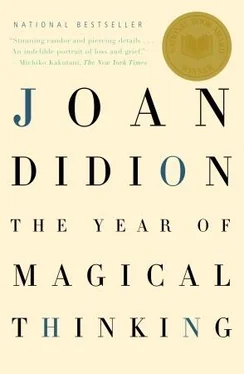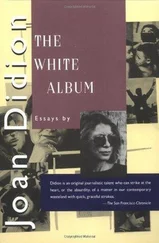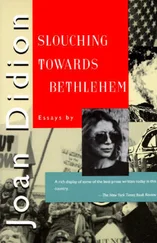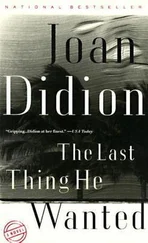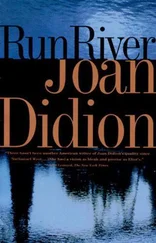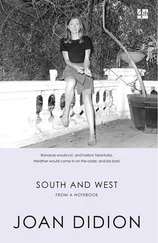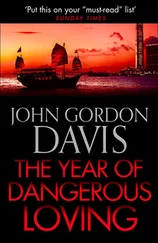I determined to spend the summer reaching the same point.
I did not yet have the concentration to work but I could straighten my house, I could get on top of things, I could deal with my unopened mail.
That I was only now beginning the process of mourning did not occur to me.
Until now I had been able only to grieve, not mourn. Grief was passive. Grief happened. Mourning, the act of dealing with grief, required attention. Until now there had been every urgent reason to obliterate any attention that might otherwise have been paid, banish the thought, bring fresh adrenaline to bear on the crisis of the day. I had passed an entire season during which the only words I allowed myself to truly hear were recorded: Wel- come to U-C–L-A.
I began.
Among the letters and books and magazines that had arrived while I was in Los Angeles was a thick volume called Lives of ’54, prepared for what was by then the imminent fiftieth reunion of John’s class at Princeton. I looked up John’s entry. It read: “William Faulkner once said that a writer’s obituary should read, ‘He wrote books, then he died.’ This is not an obit (at least as of 19 September 2002) and I am still writing books. So I’ll stick with Faulkner.”
I told myself: this was not an obit.
At least as of 19 September 2002.
I closed Lives of ’54. A few weeks later I opened it again, and leafed through the other entries. One was from Donald H. (“Rummy”) Rumsfeld, who noted: “After Princeton, the years seem like a blur, but the days seem more like rapid fire.” I thought about this. Another, a three-page reflection by Lancelot L. (“Lon”) Farrar, Jr., began: “Arguably our best-shared Princeton memory was Adlai Stevenson’s address to the senior banquet.”
I also thought about this.
I had been married to a member of the Class of ’54 for forty years and he had never mentioned Adlai Stevenson’s address to the senior banquet. I tried to think of anything at all he had mentioned about Princeton. He had many times mentioned the misguided entitlement he heard in the words “Princeton in the Nation’s Service,” the slogan Princeton had adopted from a speech by Woodrow Wilson. Other than that I could think of nothing except his saying a few days after our wedding (why did he say it? how had it come up?) that he had thought the Nassoons absurd. In fact, because he knew it amused me, he would sometimes impersonate the Nassoons in performance: the studied plunge of one hand into a pocket, the swirling of the ice cubes in the imaginary glass, the chin thrust into profile, the slight satisfied smile.
As I remember you—
We stood there together on a high windy slope — Our faces to the weather and our hearts full of hope—
For forty years this song had figured in a private joke between us and I could not remember its name, let alone the rest of its lyrics. Finding the lyrics became a matter of some urgency. I could find only a single reference on the Internet, in an obituary from the Princeton Alumni Weekly:
John MacFadyen ’46 *49: John MacFadyen died February 18, 2000, in Damariscotta, Maine, near the village of Head Tide, where he and his wife, Mary-Esther, made their home. The cause of death was pneumonia, but his health failed for some years, particularly after his wife’s death in 1977. John came to Princeton from Duluth in the ‘accelerated’ summer of 1942. Gifted in music and arts, he contributed songs to Triangle, including, “As I Remember You,” long a Nassoons favorite. John was the life of any party with a piano. Remembered was his rendition of “Shine, Little Glow Worm,” played upside down from under the piano. After U.S. Army service in Japan, he returned to Princeton for a master’s of fine arts in architecture. In the New York firm Harrison & Abramowitz, he designed a main United Nations building. John received the Rome Prize in architecture, and, newly wed to Mary-Esther Edge, spent 1952–53 at Rome’s American Academy. His private architectural practice, noted especially for the design of the Wolf Trap Center for the Arts outside Washington, was interrupted by his service, during the 1960s, under Gov. Nelson Rockefeller, as executive director of the first state arts council. The class joins his children, Camilla, Luke, William, and John and three grandchildren in mourning the loss of one of our most unforgettable members.
“As I Remember You,” long a Nassoons favorite.
But how about the death of Mary-Esther?
And how long ago was it when the life of any party last played “Shine, Little Glow Worm” upside down from under the piano?
What would I give to be able to discuss this with John?
What would I give to be able to discuss anything at all with John? What would I give to be able to say one small thing that made him happy? What would that one small thing be? If I had said it in time would it have worked?
Anight or two before he died John asked me if I was aware how many characters died in the novel he had just sent to press, Nothing Lost. He had been sitting in his office making a list of them. I added one he had overlooked. Some months after he died I picked up a legal pad on his desk to make a note. On the legal pad, in very faint pencil, his handwriting, was the list. It read:
Teresa Kean
Parlance
Emmett McClure
Jack Broderick
Maurice Dodd
Four people in car
Charlie Buckles
Percy — electric chair (Percy Darrow)
Walden McClure
Why was the pencil so faint, I wondered.
Why would he use a pencil that barely left a mark.
When did he begin seeing himself as dead?
“It’s not black and white,” a young doctor at Cedars-Sinai Medical Center in Los Angeles had told me, in 1982, about the divide between life and death. We had been standing in an ICU at Cedars watching Nick and Lenny’s daughter Dominique, who had the night before been strangled to the point of death. Dominique was lying there in the ICU as if she were asleep but she would not recover. She was breathing only on life support.
Dominique had been the four-year-old at John’s and my wedding.
Dominique had been the cousin who supervised Quintana’s parties and took her shopping for prom dresses and stayed with her if we were out of town. Roses are red, violets are blue, read the card on a glass of flowers Quintana and Dominique left on the kitchen table for our return from one such trip. I wish you weren’t home and Dominique does too. Love, Happy Mother’s Day, D & Q.
I remember thinking that the doctor was wrong. For as long as Dominique lay in this ICU she was alive. She could not keep herself alive unaided but she was alive. That was white. When they turned off the life support there would be a matter of some minutes before her systems shut down and then she would be dead. That was black.
There were no faint traces about dead, no pencil marks.
Any faint traces, any pencil marks, were left “a night or two before he died,” or “a week or two before,” in any case decisively before he died.
There was a divide.
The abrupt finality of this divide was something about which I thought a great deal during the late spring and summer after I came home from UCLA. A close friend, Carolyn Lelyveld, died in May, at Memorial Sloan-Kettering. Tony Dunne’s wife, Rosemary Breslin, died in June, at Columbia-Presbyterian. In each of those cases the phrase “after long illness” would have seemed to apply, trailing its misleading suggestion of release, relief, resolution. In each of those long illnesses the possibility of death had been in the picture, in Carolyn’s case for some months, in Rosemary’s since 1989, when she was thirty-two. Yet having seen the picture in no way deflected, when it came, the swift empty loss of the actual event. It was still black and white. Each of them had been in the last instant alive, and then dead. I realized that I had never believed in the words I had learned as a child in order to be confirmed as an Episcopalian: I believe in the Holy Ghost, the Holy Catholic Church, the Communion of Saints, the forgiveness of sins, the resurrection of the body, and the life everlasting, amen.
Читать дальше
Конец ознакомительного отрывка
Купить книгу
